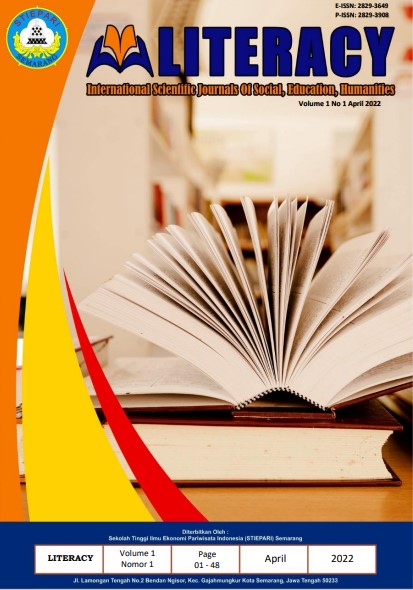LANGUAGE FORMS INDICATING THE DANI CULTURE AS DESCRIBED IN THE NOVEL SALI, KISAH SEORANG WANITA SUKU DANI
DOI:
https://doi.org/10.56910/literacy.v1i1.271Kata Kunci:
Language form, Dani culture, Sali, Dani tribe.Abstrak
There have been several studies discussing the novel Sali: The Story of a Dani Woman. These studies generally use sociological literature, feminist literary criticism, and gender perspectives. This paper comes with a different perspective, namely the ethnolinguistic approach. This paper describes the linguistic forms in the novel that represent the Dani culture and reveals the cultural meaning of the linguistic forms in the novel. The linguistic data is taken entirely from the novel and the meanings obtain apart from the novel are also from other sources as listed in the references. The results of data analysis show that linguistic forms indicating the Dani culture include the level of words, phrases, clauses, or sentences. Furthermore, the cultural meaning of language forms in terms of words indicating Dani culture, namely: (1) Abambuk which means tribal chief, Dani tribal leader. (2) Pig which means a dowry given to a girl or a widow to marry. (3) Hunting which means the dominant male activity to show his self-esteem. (4) Ebeai which means a house that a wife/woman, children and husband/men may enter to gather. (5) Fugima which means a place to end life/everything for a woman/wife who has given up on her fate. 6) Honai which means a traditional house located in silimo. (7) Koteka which means penis genital cover has many meanings. The variation indicates that the more varied the koteka, the higher the class of men who wear it. (8) Noken which means a replacement for the ballot box which means a form of appreciation for the cultural values and local wisdom of the Dani community. (9) Pilamo which means a place to limit women's movement. This was a house that only men could enter to ensure that they and the war equipment were free from the dirty blood of women. (10) Sali which means wife indexer. (11) Silimo which means a family residence consisting of honai, ebeai, and pilamo, the three of which are far from each other in a certain area. Furthermore, the linguistic forms in the form of phrases are (1) Chewing greedily which means eating food in an unethique way. (2) Tribal war which means the implementation of a war caused by a member of the Dani community was being killed. (3) Polygamous marriage which means the family of the prospective wife. (4) Cutting a child's finger which means a meaningful representation of emotional pain which is important for the process of grieving the death of the child's parents. It is a symbol of grief at the loss of a family member. (5) The cry of mourning which means that family members have to cry for a long time as hard as possible to mark the mourning of being left dead by a member of a communal system 6) Cremation, or the burning of a corpse which means an attempt to take the white ashes of the corpse. (7) Relative-exchange marriage which means marry to the wife's sister in order to get a replacement from the pig keeper, the caretaker of his children and himself. Finally, the forms of clauses/sentences indicating Dani culture are: (1) Keeping the younger sister away from her twin means avoiding bad things. The younger sister in the twins is believed to be the daughter of the devil, so she must be exiled, otherwise a disaster will come that will harm the family. (2) Leaving sali on the rocks in Fugima which means the owner has died as a form of surrendering to the problems of life that surrounds her so that in a very tragic way her life is ended.
Referensi
Aic Priharlina, Serafin. 2009. ‘Citra Perempuan dalam Novel Sali, Kisah Seorang
Wanita Suku Dani, Karya Dewi Linggasari: Tinjauan Sosiologi Sastra’. https://repository.usd.ac.id/25406/2/034114027_Full%5B1%5D.pdf
Chaer, Abdul., Leonie Agustina. 2014. Sosiolinguistik: Perkenalan Awal. Jakarta:
Chineka Cipta.
Devita, Hermawati., Rudi Ekasiswanto. 2014. ‘Citra Perempuan Suku Dani dalam Novel Etnografi Sali. Kisah Seorang Wanita Suku Dani Karya Dewi
Linggasari: Analisis Kritik Sastra Feminis Ruthven’.
https://repository.ugm.ac.id/131987/
Kramsch, Claire. 1998. Language and Culture. New York: Oxford University Press.
Koentjaraningrat.1985. Kebudayaan, Mentalitas, dan Pembangunan. Jakarta:
Gramedia.
Koentjaraningrat.1986. Asas-asas Ritus, Upacara, dan Religi. dalam Manusia Irian :
Dahulu, Sekarang dan Masa Depan. Jakarta: Gramedia.
Linggasari, Dewi. 2007. Sali: Kisah Seorang Wanita Suku Dani. Yogyakarta :
Kunci Ilmu.
Samiksha 5. Culture : The Meaning, Characteristics, and Functions. Accessed April 15,
https://www.yourarticlelibrary.com/culture/culture-the-meaning-characteristics-and-functions/9577
Samovar, Larry S, Richard E. Porter (eds). 1994. Intercultural Communication: A
Reader. Michigan : University of Michigan, Wadsworth.
Sarina, Kamsinah, E. Iswary. 2019. ‘Representasi Gender Melalui Bahasa Dalam Novel
Sali: Kisah Seorang Wanita Suku Dani Karya Dewi Linggasari’. Dalam Jurnal Ilmu Budaya. Vol 7, No 1, Juni 2019 .
Silva, Ismael, Fuenzalida. 2014. ‘Ethnolinguistics and the Study of Culture’. In American Anthropologis Coverage: 1888-2014 (Vol.1, No.1 - Vol. 116, No. 4) :
WileyISSN : 00027294 E-ISSN: 15481433. https://www.jstor.org/stable/664540.
Siswanto, S. 2010. ‘Citra Perempuan dan Ketimpangan Gender dalam Sali:Kisah
Seorang Wanita Suku Dani’. In Kibas Cenderawasih. Vol 6.no 1 (2010). Citra Perempuan Dalam Sali: Kisah Seorang Wanita Suku Dani
Underhill, James W. 2012. Ethnolinguistics and Cultural Concepts: Truth, Love,
Hate, and War. Cambridge: Cambridge University Press. E-ISBN: 9780511862540. https://doi.org/10.1017/CBO9780511862540







